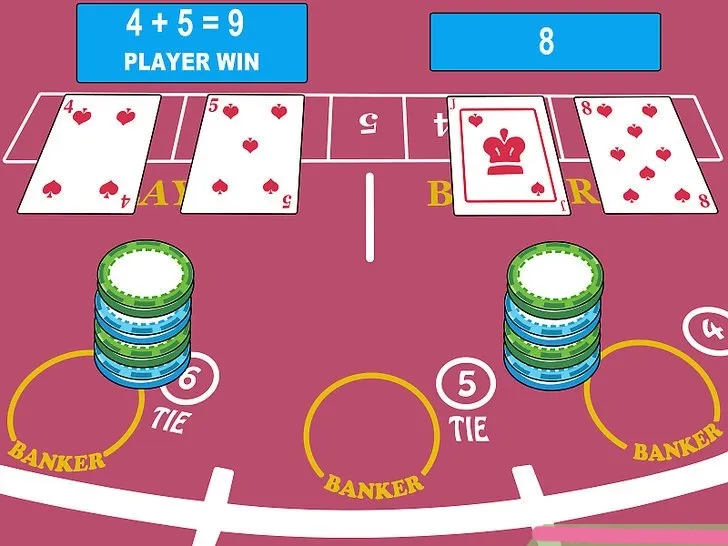Summary
Unlock the secrets to mastering baccarat with strategies that go beyond conventional play, aimed at maximizing your winnings in high-stakes games. Key Points:
- **Unconventional Tiebreaker Maneuvers:** Learn advanced techniques to enhance your odds in tiebreaker situations, pushing past standard rules for bigger wins.
- **Exploiting Baccarat Drawing Patterns:** Understand and utilize drawing patterns to gain a competitive edge over the dealer and other players.
- **Banker Hand Mastery: Unveiling the Banker's Advantage:** Discover the inherent advantages of the banker's hand and develop strategies to exploit these benefits.

Here's the deal: in this game, you're essentially working with two options for your money. One is known as the Banker's hand, and the other is called the Player's hand. What's interesting here is that you get to decide where to place your bet; it's entirely up to you! Think about it - having that kind of freedom is pretty awesome, right? But keep in mind, you have to make your bet before any cards are revealed. It's all about timing and making every second count. So, be sure you've made up your mind before those cards hit the table!

Here’s the scoop: both the Player and Banker are dealt two cards each. Sounds intriguing, right? It’s like gearing up for a mini showdown! Imagine this: either a player or the casino dealer, whoever is in control of the shoe, slides out the first card and places it face-up in the Player's box on the felt table. Next, they draw another card and set it in the Banker’s box. And don't blink—it happens quickly! The house then deals another card to the Player, followed by a second one to the Banker.
It’s all quite systematic, actually. By the end of this initial dealing phase, both sides—the Player and Banker—have two cards each. Voilà! The game is now officially underway.

Tiebreakers and Burning the Deck: Unpredictable Elements in Card Games
In the event of a tie, the player with the highest-ranking card in their hand wins. For example, if Player A has a hand with a 6 and a 3, totaling 9, and Player B has a hand with a 5 and a 4, also totaling 9, Player A wins because their highest-ranking card is a 6 compared to Player B's highest-ranking card of 5.Additionally, to add an element of unpredictability to the game, there is a unique feature called 'Burning' the deck. Before any cards are dealt to the players, the top card of the deck is flipped over and placed face up on the table. This burn card determines how any Aces drawn during that round will be valued. For instance, if the burn card is a 2, then all Aces count as 2 points for that round. Conversely, if an Ace is revealed as the burn card, it would imply that all other Aces in play count as just 1 point. This rule adds strategic depth by altering how players value their hands based on this initial reveal.

It's one of those heart-stopping moments in the game. Here's the lowdown: if either the Player or the Banker ends up with an 8 or 9 from their initial two cards, that's an instant win—what we call a natural. The round concludes right then and there, almost like a sudden dramatic twist. As soon as those cards flip to reveal an 8 or 9, it's game over. No more dealing, no more suspenseful waiting. The bets placed are settled immediately—just like that. It's this kind of swift resolution that keeps your adrenaline levels soaring!

First and foremost, you need to tally up the points. The Player's hand gets resolved first every time. If their total hits 8 or 9, that's game over for them - no additional cards are drawn. They stick with that hand. On the other hand, if their score lands at 6 or 7, they also hold steady.
Now here's where things get a bit more intriguing: should the Player's total fall between 0 and 5, they draw a third card - unless the Banker is sitting pretty with an 8 or 9 already. In that scenario, the Banker scoops up the win without any further action needed. It's pretty simple when you break it down like this! So remember to keep those point totals in check and pay close attention to each card dealt!

Baccarat Drawing Rules: A Strategic Guide to Player and Banker Hands
In the intricate game of Baccarat, understanding the drawing rules for both the Player and Banker is crucial. These rules dictate how each side draws additional cards based on their current hands, with particular attention given to specific values of the Player's third card. For instance, if the Player's third card is an Ace, the Banker will draw a card if they possess a hand value between 0 and 2, but will hold steady with a hand value between 3 and 7. Conversely, if the Player's third card is a 2, then the Banker will draw if their hand value falls between 0 and 3, choosing instead to remain stationary with a hand value ranging from 4 to 7.These nuanced conditions highlight not only the strategic depth involved in Baccarat but also underscore why familiarity with these rules can be advantageous for players looking to maximize their success at the table. Such detailed regulatory knowledge allows players to anticipate outcomes more accurately and make more informed betting decisions throughout gameplay.
Mastering the game hinges on knowing exactly when to make your move and when to stay put. Once you grasp these fundamental strategies, you'll gain a much deeper understanding of the game's rhythm. Ultimately, it's all about those pivotal choices and the way the cards play out!

Alright, you've laid out all your cards – so what's next? It's time to determine the winning hand. The process is pretty simple: the hand that gets closest to a total of 9 wins. But here's an interesting twist – if both hands end up with the same value, it's a tie, meaning neither side wins or loses. It's like hitting a stalemate in chess.
For those placing bets on the Banker's hand, here's a quick heads-up: sometimes there's a commission deducted from your winnings. It’s not much, but it’s something to keep in mind when betting on the Banker. So as you assess all the cards before you, just remember that aiming for that magic number 9 is key!



 ALL
ALL
Discussions